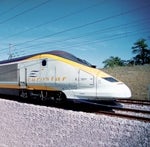Fresh identity marks Eurostar’s fresh start

With the introduction of a new visual identity and revamped product and service offering, Eurostar is trying to take advantage of the commercial opportunities that changes to the law and its business structure have presented. Changes, the company hopes, will help it usurp both air and train rivals by becoming Europe’s “most loved travel experience”.
The company has today (28 March) unveiled a new logo that drops the three lines representing the three countries that Eurostar previously operated in – England, France and Belgium – in favour of a lower case e with a single line passing through.
The move is designed to represent the new commercial freedom that a change to European law, as of 1 January 2010 train operators could start to run services anywhere in the European Union – has afforded Eurostar.
The company also wants to expand the Eurostar brand across a larger geographical area and plans to partner with other operators to offer products and propositions in countries such as Germany and Holland.

Nine months on, a structural change within the company – it moved from being a joint venture between partners in England, France and Belgium into a single, unified corporate entity – has presented its management with the opportunity to take advantage of the change in the law.
The company is investing £700m in its fleet, including the purchase of 10 new trains. It has also taken steps to improve service by introducing the Avantage customer service training programme.
Its leisure product will be augmented by increasing the number of partnerships with cultural and leisure attractions in more countries. The company will also look to sign more celebrity advisers with a soon to be announced celebrity chef to advise travellers on dining out. Musician Jarvis Cocker already offers advice on culture.
Its Business Premier service will also be bolstered with the addition of flexible ticketing so that business travellers can fly anytime on the day the ticket is bought for, while a mobile product will allow customers to buy and enter a platform without a ticket.

The enhancements to its service offering are an attempt to approach segmentation in the same way as airlines that serve both leisure and business travellers. It is, alongside the plans to expand its geographical reach, also part of Eurostar’s long-term aim of going head to head with short-haul airlines such as easyJet and Ryanair, as well as other train operators.
Eurostar commercial director Nick Mercer believes that by boosting products and customer service, Eurostar can fill a gap in the travel market.
“Europe, from a travel perspective is an unbelievably commoditised market. When you travel in Europe there is no loyalty or affinity”.
He adds: “You are often on trains longer than you are on a plane. If you are clever – you can take a long-haul travel experience and encapsulate that in Europe. We want to make Europe’s most loved travel experience. Why can’t you make travel and the experience of travelling in Europe and enjoyable thing.”
Emma Harris, sales and marketing director says the new logo also offers the chance to make the Eurostar brand consistent across all markets.

“From a brand perspective, we have previously developed very different identities in each of our core markets, however, as we compete in a deregulated market and expand our reach across Europe, it’s vital that we have a consistent brand in all markets.”
The company has to up its game. Deregulation has offered Eurostar the chance to compete in other operators’ home markets. It has, however, also offered the likes of German train operator Deutsche Bahn – which has already said it will run services from London to Frankfurt and Amsterdam from next year – the chance to take it on.
The short-haul carriers that it hopes to steal share from are bolstering their business travel offers. Easyjet has introduced its own flexible ticket, while BA has also recently moved to make its business service offering.
The company is still, in many minds, associated with stranded customers and travel chaos that followed snow in December 2009 and again last year. Mercer, however, insists that the company has learned from this and undergone a “profound change” in the way it communicates with customers, using social media to keep customers updated of any changes.
Eurostar, however, has a number of factors in its favour. Customer numbers are already increasing, up 3% last year. Its sponsorship of the London 2012 Olympic Games will also put it front of consumers’ minds across Europe next year.
“We are already a brand”, Mercer adds, “Why can’t we take what seems like a commoditised product – buying a ticket from a to b – and add value to that, bringing the brand more to life “.
Timeline
- May 1994 First Eurostar train to Calais
- Sept 2007 Inaugural journey between Paris Gare du Nord and St Pancras International
- December 2009 The company receives criticism after snow left passengers stranded
- August 2009 Carries its 100 millionth customer
- September 2010 the company moves from being an unincorporated joint venture into a single, unified corporate entity







